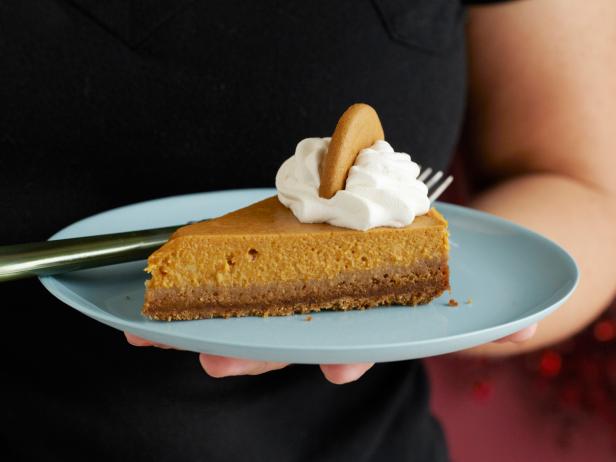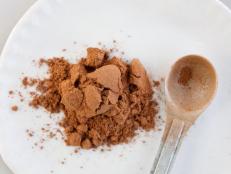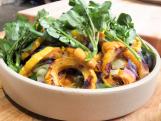How to Make Pumpkin Pie

Before you bake Thanksgiving's most iconic dessert, you might have some questions about what type of pie dough to use, whether your filling should be canned or fresh and how to achieve a perfectly textured pie with a no-cracks custard. Below, harvest all the top tips for turning out a classically creamy, perfectly spiced pumpkin pie that deserves center stage at the Thanksgiving dessert table.
The Crust: Store-bought or Homemade?
A store-bought pie shell will certainly suffice in a last-minute pinch, but it’s worth making a buttery crust from scratch to match your sweetly spiced pie filling. It’s not that much extra work, and this detailed step-by-step guide makes the process even easier. You can make and freeze the dough about a week in advance, so it won't get in the way of your main Thanksgiving prep, either. When you're ready to make the pie itself, be sure to weigh down and blind bake the pie crust before adding in the filling. This keeps the crust from lagging behind the filling during baking and turning soggy.
The Filling: Canned or Fresh?
The answer to this age-old question depends greatly upon time constraints around the holidays. Using canned pumpkin puree is more convenient than preparing and roasting a fresh pumpkin, and many pastry chefs use it themselves in pumpkin pie recipes. It's very smooth and boasts a deep flavor and consistent moisture content. Just be sure to choose 100-percent pure pumpkin puree instead of overly sweet, pre-spiced pumpkin pie filling. This way you'll be able to control the amount of sugar and spices added to the filling and work with fresh spices. Fresh pumpkin has a milder flavor and requires you to peel, chop and remove the seeds from the squash, roast it, then puree the pieces (a considerable effort). It also contains more moisture, which can sometimes lead to watery custard if the pumpkin is not drained after pureeing. While fresh pumpkin will result in a lighter-color pie with a nicely dense texture, it requires a little more work than simply opening a can.

2012, Television Food Network, G.P. All Rights Reserved.
Ginger Snap Pumpkin Pie with Ginger Cream.
If You Choose to Go Fresh: Pick the Perfect Squash
The traditional choice for pumpkin pie is the small sugar pumpkin. They are known for their slightly sweet and meaty flesh that is well-suited for use in baked goods. While their flesh is less stringy than that of large cheese pumpkins (the go-to for jack-o'-lanterns), they still require a little elbow grease to cut open, scoop out the seeds and chop into pieces for roasting. To ensure the smoothest texture, puree the roasted pumpkin thoroughly, run it through a sieve to weed out any strings and drain it through double-lined cheesecloth to remove excess moisture.
But arguably the best choice for pumpkin pie filling is actually butternut squash. Butternuts are naturally sweet, can be peeled easily, have very few seeds and produce a silky-smooth puree. Just chop the squash into cubes for quick cooking and roast them in the oven until they are tender and caramelized. Puree the cubes in a food processor until they're smooth and velvety.
Use Seasonal Spices
Freshly baked pumpkin pie should fill the kitchen with the comforting aroma of warm spices like cinnamon, nutmeg, cloves and ginger. Pumpkin pie spice, a pre-mixed blend of these spices in a bottle, provides a convenient option for capturing all of those fall flavors in one package. The only benefit to adding the spices individually is that you can adjust the levels of each spice to your preference.
Add Creamy Company
Not all pumpkin pie recipes require milk, but adding it in some form can help the filling achieve a creamy and luscious consistency. Options range from heavy cream to evaporated milk to sweetened condensed milk and even melted ice cream. Be aware that too much regular milk can create watery custard, while sweetened condensed milk is quite thick and includes added sugar, so it’s best to account for the extra sweetness by using less sugar in the filling. For a rich and smooth cheesecake-like pie, try using cream cheese in place of milk, which will create a silky, dense filling with added tang.
Whisk Wisely
Whisk the wet and dry ingredients for the filling by hand instead of using a mixer, as heavy-duty mixing can lead to a gluey, tough texture. Also avoid over-whisking, as this incorporates too much air into the filling, which can cause the pie to rise and fall, then crack. Add the warm filling to a warm pie crust; this will encourage the filling to cook more quickly and reduce the risk of curdling, as well as help keep the crust crisp.

The Sweet Spot
Place the pie on a baking sheet in the lower third of the oven when it’s ready to bake. Putting the pie too close to the heating element at the top of the oven can create a skin and cause the filling to crackle. Baking the pie on a sheet pan also keeps the crust crisp and catches any overflow from a fully filled pie.
Jiggly and Just Right
Bake the pie at a high temperature (425 degrees F) for 10 minutes, then reduce the oven temperature (to 350 degrees F) for the remainder of the bake time. This will cut the baking time to under an hour and produce evenly cooked custard. Don’t overbake! Check the pie frequently, as overbaking will lead to cracks. The pie is ready when it is mostly firm but still a little jiggly in the center. Take it out at this point and it will finish cooking from residual heat. Let the pie cool at room temperature, as chilling it in the fridge will produce a soggy crust.
Festive Toppers
Cap the ultimate pumpkin pie with freshly whipped cream (which doubles as delicious cover-up for any pesky cracks that occur), a brown sugar streusel, chopped toasted nuts, a fluffy meringue or use cookie cutters to make fall-centric shapes with leftover pie dough and arrange them on top of the custard before baking.
Pick a Recipe
Now that you're armed with professional advice, decide whether you'll be baking a classic, conventional pumpkin pie, or testing a creative twist.
Watch and Learn
Still have questions? Cooking Channel chefs show you how they bake the perfect pumpkin pie.








